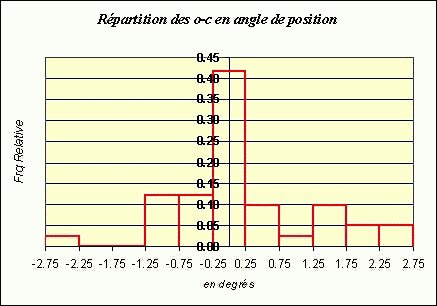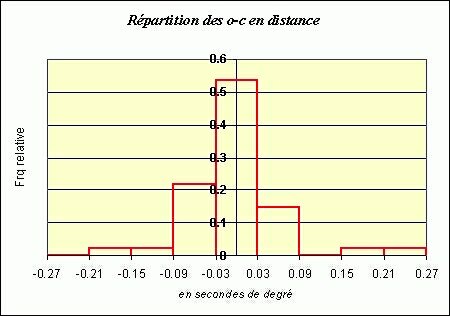ACCURACY
An instrument can garanty a certain amount of precision (weak dispersion of measurements)
but it must also be accurate.
Only the confrontation to calibration standards permits to quantify
this accuracy.
This table takes the set of the 41 double stars visited at least
two times and compares the measurements to Hipparcos catalog (1991.25).
The calibration stars used each night come from the HDM, it appeared
more reasonable to take HDM measures for the o-c calculation in
order to have an homogeneous reference basis.
The relative positions from Hipparcos are not corrected of the yearly
variations signalled in HDM.
Some of the double stars are orbital. For those, o-c calculation
is done in regard of the ephemeris calculated at the epoch of the
measure.
qo,
ro
= measures
qc,
rc
= HDM, éphémérides
qo-qc
= angle of position residues
ro-rc
= separation residues
| Star |
Epoch |
qo |
ro |
N |
qc |
rc |
qo-qc |
ro-rc |
| STF664 |
2001.933 |
175.515 |
4.799 |
2 |
174.90 |
4.798 |
0.62 |
0.001 |
| STF563 |
2001.934 |
31.663 |
11.770 |
3 |
31.60 |
11.75 |
0.06 |
0.020 |
| STF572 |
2001.934 |
10.260 |
4.264 |
3 |
11.18 |
4.212 |
-0.92 |
0.052 |
| STT84 |
2001.934 |
255.307 |
9.537 |
3 |
255.27 |
9.49 |
0.04 |
0.047 |
| STF877 |
2001.962 |
263.670 |
5.625 |
2 |
263.52 |
5.625 |
0.15 |
0.000 |
| STF1374 |
2002.181 |
307.387 |
2.797 |
3 |
304.90 |
2.922 |
2.49 |
-0.125 |
| STF1417 |
2002.181 |
257.630 |
2.282 |
3 |
257.90 |
2.37 |
-0.27 |
-0.088 |
| STF1419 |
2002.181 |
224.780 |
4.472 |
3 |
224.60 |
4.46 |
0.18 |
0.012 |
| STF1757 |
2002.286 |
129.210 |
1.949 |
2 |
127.30 |
1.982 |
1.91 |
-0.033 |
| STF1764 |
2002.286 |
30.700 |
15.880 |
2 |
31.50 |
15.87 |
-0.80 |
0.010 |
| STF1755 |
2002.288 |
130.700 |
4.212 |
3 |
130.62 |
4.274 |
0.08 |
-0.062 |
| STF1785 |
2002.288 |
174.820 |
3.310 |
3 |
174.70 |
3.29 |
0.12 |
0.020 |
| STF1793 |
2002.288 |
242.580 |
4.795 |
2 |
242.42 |
4.779 |
0.16 |
0.016 |
| STF1603 |
2002.289 |
82.650 |
22.288 |
2 |
82.48 |
22.31 |
0.17 |
-0.022 |
| STF1639 |
2002.289 |
326.260 |
1.717 |
2 |
324.40 |
1.728 |
1.86 |
-0.011 |
| STF1645 |
2002.289 |
157.230 |
9.758 |
2 |
157.50 |
9.808 |
-0.27 |
-0.050 |
| STF1685 |
2002.289 |
201.575 |
15.966 |
2 |
201.45 |
15.94 |
0.13 |
0.026 |
| STF1719 |
2002.289 |
358.660 |
6.936 |
2 |
359.00 |
7.013 |
-0.34 |
-0.077 |
| STF1633 |
2002.331 |
245.238 |
8.964 |
4 |
245.33 |
8.953 |
-0.09 |
0.011 |
| STF2051 |
2002.392 |
18.837 |
13.877 |
3 |
18.71 |
13.86 |
0.13 |
0.017 |
| STF2052 |
2002.392 |
124.820 |
2.105 |
3 |
123.30 |
2.022 |
1.52 |
0.083 |
| STF2078 |
2002.392 |
104.987 |
3.156 |
3 |
105.90 |
3.208 |
-0.91 |
-0.052 |
| H7 |
2002.396 |
19.755 |
13.576 |
2 |
20.60 |
13.66 |
-0.85 |
-0.084 |
| STF1999 |
2002.397 |
98.913 |
11.802 |
4 |
98.75 |
11.73 |
0.16 |
0.072 |
| STF2021 |
2002.397 |
354.853 |
4.120 |
4 |
354.20 |
4.097 |
0.65 |
0.023 |
| STF2032 |
2002.397 |
236.553 |
7.028 |
4 |
236.20 |
7.05 |
0.35 |
-0.022 |
| STT303 |
2002.397 |
172.293 |
1.368 |
4 |
169.70 |
1.44 |
2.59 |
-0.072 |
| STF2097 |
2002.414 |
80.315 |
1.933 |
2 |
80.50 |
1.957 |
-0.19 |
-0.025 |
| STF2079 |
2002.415 |
90.647 |
16.848 |
3 |
90.54 |
16.83 |
0.11 |
0.018 |
| STF2085 |
2002.415 |
309.460 |
6.045 |
3 |
309.30 |
6.07 |
0.16 |
-0.025 |
| STF2095 |
2002.415 |
160.073 |
5.318 |
3 |
160.33 |
5.29 |
-0.26 |
0.028 |
| STF2101 |
2002.415 |
48.317 |
4.114 |
3 |
49.20 |
4.13 |
-0.88 |
-0.016 |
| STF2104 |
2002.415 |
18.303 |
5.672 |
3 |
18.29 |
5.697 |
0.01 |
-0.025 |
| STF2130 |
2002.415 |
16.673 |
2.280 |
3 |
15.40 |
2.239 |
1.27 |
0.041 |
| STF2135 |
2002.415 |
192.453 |
8.432 |
3 |
190.86 |
8.276 |
1.59 |
0.156 |
| STF2161 |
2002.47 |
319.637 |
4.066 |
3 |
318.29 |
4.066 |
1.35 |
0.000 |
| STF2165 |
2002.47 |
61.037 |
10.056 |
3 |
60.11 |
9.79 |
0.93 |
0.266 |
| STF2178 |
2002.482 |
128.240 |
10.613 |
2 |
128.00 |
10.676 |
0.24 |
-0.063 |
| STF2218 |
2002.482 |
316.505 |
1.443 |
2 |
319.10 |
1.602 |
-2.60 |
-0.159 |
| STF2245 |
2002.482 |
291.745 |
2.601 |
2 |
292.10 |
2.613 |
-0.36 |
-0.012 |
| STF2259 |
2002.482 |
277.455 |
19.677 |
2 |
277.17 |
19.64 |
0.28 |
0.037 |
|
Although the measures have been done with two different
optic installations the histograms don't have a multi-modal pace.
In the two graphs, the distribution has very strong density around the
o-c=0 value.


CONCLUSION
These 18 past months to aim webcams on double stars
converted me definitely. Whatever is the camera the results are always
at the height of that is previously exposed. The quality of the measurements
and constancy are far better than all I obtained with the micrometer on
the same telescope.
When reading forums or discussion groups on internet, it seems that double
stars observation keeps a good place in amateur activity. The webcam could
open a way toward the amateur astrometry for those who want to do some
more than simply observing for the fun.
Contrary to the micrometer, the financial investment is weak and the methods
are simple, the number of couples visited in one evening is without comparison.
Let's imagine a small network of motivated duplicists working on a common
program. Without looking for records of separation or magnitude, thousands
of interesting couples are accessible to a simple instrumentation.
A little care and some method when imaging, some computer tools for the
reductions and one can get involved in an useful double stars measurements
program.
<<<

